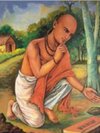Ane exhibition was held to spread awareness on India's rich scientific heritage. The exhibition coordinator, Ashish Manjramkar stated:
"Very few of us know that speed of light was known to Indians in Vedic period. A shloka says that the speed of light is 2202 yojana per half nimish. Yojana is a unit of distance which equals to 9.06 miles and half a nimish (nimishardha) is one tenth of a second. The figure is very close to the modern measurement of speed of light."
When we talk about gravity, the first name that pops into our heart is "Sir Isaac Newton". In school we all have been told the story of how Newton was inspired to formulate "The Universal Law of Gravitation" when an apple fell from a tree. The world believes that Newton was the first to discover the gravitational concepts. You will be surprised to known that the theory of gravitation was created 1200 years before Newton by an Indian Mathematician Bhaskaracharya.
Before discussing Bhaskaracharya's contribution let us understand the basic concept of gravity.
Gravity is a universal force that allows a mass of body to attract other masses of body. The bigger a mass of body is, the higher will be the force of gravity.









